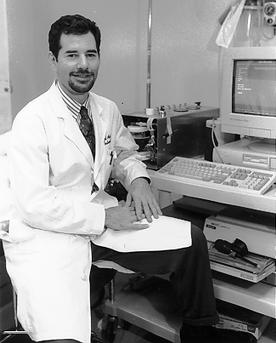
Dr. Howard Mertz oversees a new program at VUMC that uses biofeedback training to help remedy fecal incontinence.
Biofeedback training used to help ease fecal incontinence
Vanderbilt University Medical Center is offering a new service designed to help people suffering from the debilitating condition of fecal incontinence.
The disorder is more common in elderly populations, and is marked by the inability to recognize and control bowel movements. Fecal incontinence strikes 0.6 percent of the general population aged 15-64. That number, however, climbs to 2-3 percent for people aged 65 and older.
VUMC's new service, the only one of its kind in Middle Tennessee, offers a way to reduce those numbers, said Dr. Howard R. Mertz, assistant professor of Medicine.
"For a problem that most people think is untreatable, we can usually improve or eliminate incontinence in about 80 percent of people by using biofeedback training and bowel training."
Biofeedback training has been used successfully for many years and involves monitoring bodily activities that ordinarily aren't monitored. Whether it's heart rate, respiration or anal muscle activity, patients can be taught how to manipulate their own body's activities.
"A lot of things that are thought to be involuntary actually can be controlled," Mertz said. "Anal muscles are in that category. Anal contraction is one of those automatic reflexes that people are generally not aware of."
Some fecal incontinence problems are caused by a tear in the sphincter, in which case surgery is called for. This cause, however, only accounts for 20 percent of cases, Mertz said.
"Most problems aren't due to torn sphincters, they're due to weakness of the anal sphincter muscle, which is a voluntary muscle. A normal person can detect an impending bowel movement as it enters the rectum. The anal muscles are contracted to hold back the bowel movement until the appropriate time.
"But in people who are incontinent, either they don't feel the bowel movement coming or they can't make a prolonged squeeze to prevent the bowel movement. Sometimes it's both.
"Usually, surgery is not effective for that sort of sensory problem or diffuse weakness of the muscle. What does help is biofeedback, which can do two things – you can measure the activity of the sphincter muscle and you can train people to exercise it and strengthen it."
The first step is diagnosing the problem. Through VUMC's new program, patients are first evaluated by Mertz and undergo testing to determine if their incontinence is due to a muscle tear. If not, they begin biofeedback therapy training to increase control of the anal muscles. This portion of the program was made possible by the recent addition of Judy Greer, R.N., to the staff, Mertz said.
"She has experience with anal/rectal biofeedback, and she's expert at it. We now have all the components in place for comprehensive management of fecal incontinence. We have the diagnostic equipment. I do the evaluations and can identify the various factors and problems and patients whose problem can be remedied surgically and Judy is available for the biofeedback training."
Once a person has been identified as a biofeedback candidate, they come in for several training sessions and their progress is monitored, much like in conventional physical therapy, Mertz said.
"Generally, after a few sessions, the strength of the sphincter increases and the ability to hold a prolonged squeeze increases. It doesn't take long. After a week or two of practice and training we start seeing noticeable results. The key is the patient has to be motivated and cooperative enough to practice at home."
Due to the nature of the condition, many people are reluctant to seek treatment for fecal incontinence.
"Until you have a problem with it, it's easy to take something like control of defecation for granted," Mertz said. "But incontinence can have a dramatic effect on the quality of people's lives because they have to stay near the toilet. A lot of people's lives are basically ruined by incontinence, and it often leads to an elderly person being institutionalized.
"But it is a treatable problem, and we now have that treatment here."













